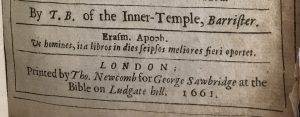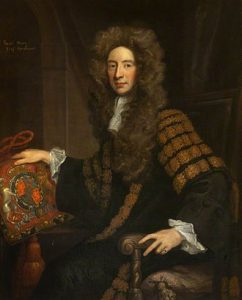
Cover page of Blount’s Glossographia, 1661 edition
Thomas Newcomb was one of the few who dominated printing in London after the great fire, and was active for 33 years. He printed over 1000 works in his lifetime.
The first addition of Glossographia was sold by Humphrey Moseley as well as George Sawbridge. More is known about Moseley than Sawbridge.
Moseley was acknowledged as a Royalist publisher. During the years when plays were banned in the Puritan regime, Moseley collected many play manuscripts. He mainly published works by Royalist sympathizers, which explains his working relationship with Blount. Surprisingly, Moseley also published the Poems of John Milton.
Moseley was a very productive publisher, and was a member of the Stationers Company, a recognized guild in London.
Sawbridge was a wealthy bookseller in London, and also had considerable power in the Stationers Company.
This crest was found pasted inside the cover of this particular copy of Glossographia.

Crest attached to cover of Blount’s Glossographia, 1661 edition
Sir Patrick Hume was anti-Catholic, and supported William of Orange. After the revolution of 1688, he returned to Britain, and his estates were then returned to him. I wonder what he made of some of Blount’s definitions (see Inside Glossographia). Nevertheless, his ownership of the book provides evidence that Blount’s works were bought by the wealthy, although intended for a wider scope.

Sir Patrick Hume, 1st Earl of Marchmont
